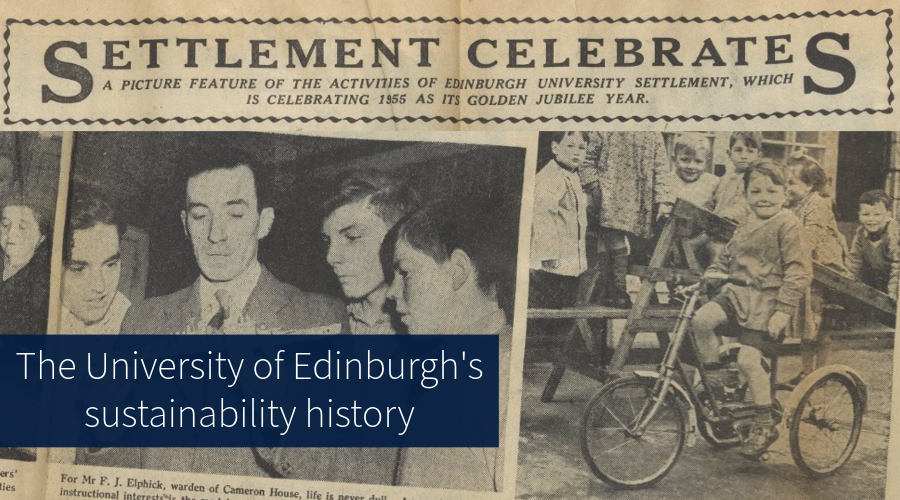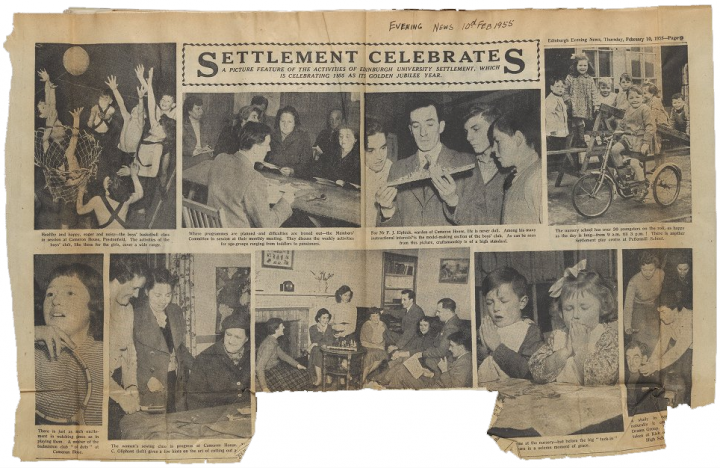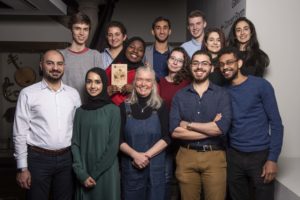The University of Edinburgh’s sustainability history

The University’s vision to make the world a better place is rooted in its unique history as a civic university.
Find out how the University tackled societal and environmental challenges in the last 100 years, and how this led to the creation of the University’s Department for Social Responsibility and Sustainability.
From the University’s founding in 1583 teaching law and divinity to the first Natural Sciences classes taught in 1705, to the discovery of carbon dioxide by then-recent-graduate Joseph Black in 1754, research and teaching at our university have always been concerned with societal and global challenges.
Settlement

It was in 1905, with the founding of the Edinburgh University Settlement, that staff and students made a concerted effort to improve living conditions in our city.
The first group of 12 ‘settlement students’ moved into High School Yards – where our Department for Social Responsibility and Sustainability is now based – exchanging cheaper rent for community work and fundraising.
The Settlement worked to raise funds to improve poorer part of the cities, creating many of Edinburgh’s civic buildings including churches, fire stations and schools.
Action to tackle social problems in the city coincided with the world wars and work moved towards programmes to help train and reskill those returning from the fighting. As late as 1994, a project worked to help women and people with disabilities learn how to use computers.
Climate change
Meanwhile, academics were beginning to get a better understanding of our impact on the environment.
Geography teaching moved High School Yards in 1934, and in 1944 the University started to teach Meteorology on the site. By the 1980s, climate change was being actively researched and understanding of the potential risk to society was growing.
The University, becoming mindful of the rising concern and following the oil crises, employed its first Energy Manager and established its first energy management strategy in 1989, and then an environmental policy a few years later. That staff member, David Somervell, became the University’s first Sustainability manager.
At the turn of the millennium, the University made a significant investment in low-carbon energy with the opening of one, then two and eventually five combined heat and power stations (CHPs) that made electricity and gas at the same time – saving thousands of tonnes of CO2 per year.
An energy-saving programme was also started, asking staff to try and save power by switching off lights and turning down their heating, alongside a project to estimate the carbon footprint of all the University’s computers.
The first transition university

Just as the Settlement had united students and staff to tackle poverty, climate change brought them together again.
In 2008, Transition Edinburgh University was established, based on the Transition Towns model of grassroots organisations doing practical things to help prevent climate change.
Funded by the Scottish Government’s Climate Challenge fund, six programmes looked at our home energy use, leisure travel, food, and waste.
The project spoke to nearly ten thousand students, and signed up more than one thousand to take part in carbon-saving activities such as an annual clear-out to share things left behind by departing students, or one-on-one home visits to help students make their private rental flats more sustainable.
From student project to university department

In early 2011 it became clear that the Climate Challenge Fund would not continue to fund the Transition Edinburgh University project.
Two programmes became social enterprises – the Hearty Squirrel Food Co-operative and Student Reuse Hub (SHRUB). Both have grown much bigger, and are still supported and enjoyed by staff, students and the University.
The project team believed that the University might benefit from the approaches that the Transition project had relied on, and so pitched an ‘energy engagement’ project to the Estates department.
A small team of four delivered the “Ashworth Pilot” in just six weeks, knocking on the doors of everyone in the Ashworth laboratories and asking them to think about how they could help the environment.
This short pilot at one building became a three-month pilot at six, and then a one-year pilot at twenty buildings. By June 2012, the team had knocked on more than a thousand doors, identified more than a hundred sustainability projects, and saved about £82,000 and 280 tonnes CO2e .
It became clear that the pilot project worked mostly not because staff were changing behaviour – as the team had hoped – but because it was finding, reporting and sometimes fixing practical problems that weren’t visible to the University’s central management.
These problems became pet projects for the team: whether it was relocating an off-switch from the roof of a building, fixing a light that had been left on for four years, or negotiating between teams to combine doubled-up resources.
That same June, the University decided to establish a department that would merge the remaining Transition team members with the small Sustainability Office, and take on responsibility for identifying and delivering on its extensive commitments.
In November 2012, the University advertised for a Director of Social Responsibility and Sustainability to “manage a new department, which will engage with staff, students and wider external communities of interest, to take forward social responsibility and sustainability developments”.
Finally, in the first half of 2014, the Department for Social Responsibility and Sustainability was launched: the first of its kind in the UK.
Note: this article was originally published in 2018, and was moved from the University’s sustainability website to its blog in 2024.





Recent comments